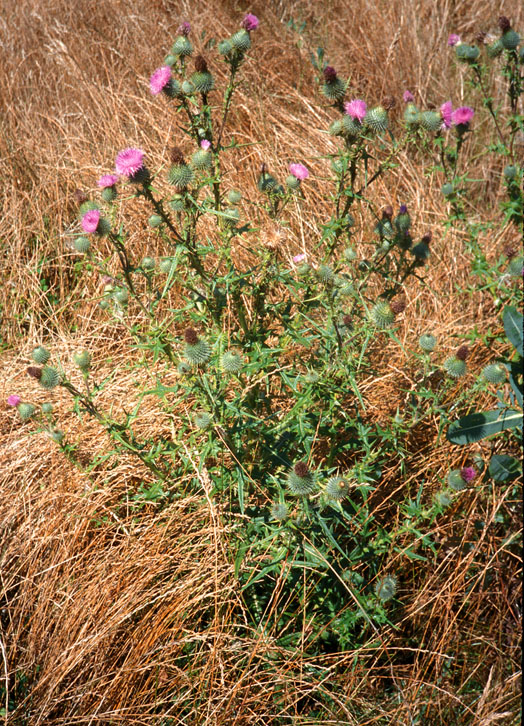
|
| Bull Thistle; Cirsium vulgare (Savi) Tenore |
Sunflower Family; COMPOSITÆ (ASTERACEÆ)
|
| By their spines ye shall know them. Proper thistles are
thorny, and if not bristling with defensive spines, are in other
respects reminiscent of their armored associates. Bull Thistle, however, as if carrying a chip on its shoulder, has developed its weaponry to
an extreme. Of all common weeds it is easily the
most inimical to human flesh. Stinging nettles we can crush with ease, as well as deftly
handle both rose canes and blackberry stems. But Bull Thistle's fiendishly piercing, razor-sharpness defies leather gloves, and causes blood to
flow, tears to run, swearing and raging. The bully of the playfield, it puts to shame such as share its name: Canada Thistle (weed of the
month August 1987), Sow Thistle, Globe Thistle, Star Thistle,
etc. |
| Bull Thistle is also called Spear Thistle, Plume Thistle, Boar Thistle and Scotch Thistle (thistles in general are Scotland's
floral emblem). As is usual with weeds, Bull Thistle is an Old World immigrant to our shores, and has become so naturalized here that we
might as well yield and learn about it; our
native thistles are vastly outnumbered by this bodyguarded intruder. Invested with charm it is not,
yet commanding our notice by its pre-eminent ability to do us injury. |
| An annual or biennial herb, it begins life usually by germinating in fall, growing as an flattish evergreen through the winter,
then flowering during summer. The very healthy
dark color of its leaves is striking, and the numerous short white hairs, not to mention the
spines, make for a devilishly handsome appearance. By June it can bloom. Each plant sends up one stout, hollow flowerstem, that can reach
over 7 feet tall; many individuals produce a circle of secondary stems around the main one. The deeply lobed, painfully prickly leaves are
simply as revolting to gardeners as is broken glass to bicyclists. But the flowers, from June to October (rarely later), are lovable pink-purplish
sweet things. After the flowers are pollinated, the lively pink petals fall away and the swollen bristly crown produces puffy
brownish-white seedheads, a crude scraggly mess compared to the exquisitely modeled Dandelion versions. But a success nonetheless. |
| The weed tolerates compacted, poor ground, and any sort of soil. It needs practically no moisture, and can get by with little
sunshine, too, although greatly benefits from much. To combat an infestation of Bull Thistles, uproot the
young plants. If you have mature flowering and seeding specimens, beware tossing their seeds, or indeed their thorny foliage, onto your compost pile. Better to banish them
entirely from your bit of earth. |
| Although Bull Thistle is wicked to tangle with, the
reason it's so needle-like in its defense is because it tastes good. Other plants
may be thornless but bitter, or even poisonous, or too fuzzy to chew. Yet Bull Thistle, if bred into a
spineless race, would be a welcome
vegetable. Its plump whitish taproot is edible, as well as its despined leaves (a tedious chore), its peeled stalks, and its flowerbuds (it is an
Artichoke relative, after all). |
| The seeds are prized as food by Goldfinches, Washington's State Bird. William Cobbett (1762 - 1835), the famous English
political and agricultural pamphleteer, wrote in early September of 1826: "Between Somerford and Ocksey, I saw, on the side of the road,
more goldfinches than I had ever seen together; I think fifty times as many as I had ever seen at one time in my life. The favourite food of
the goldfinch is the seed of the thistle. This seed is just now dead ripe. . . . The French call this bird by a name derived from the thistle, so
notorious has it always been, that they live upon this seed.
Thistle is, in French, Chardon; and the French call this beautiful little bird
Chardonaret." |
And so, too, do bees and butterflies love the grim thistles.
|
Originally published as the Seattle Tilth newsletter Weed of the Month in December 1991, along with an illustration from a book.
Back |
|
|

